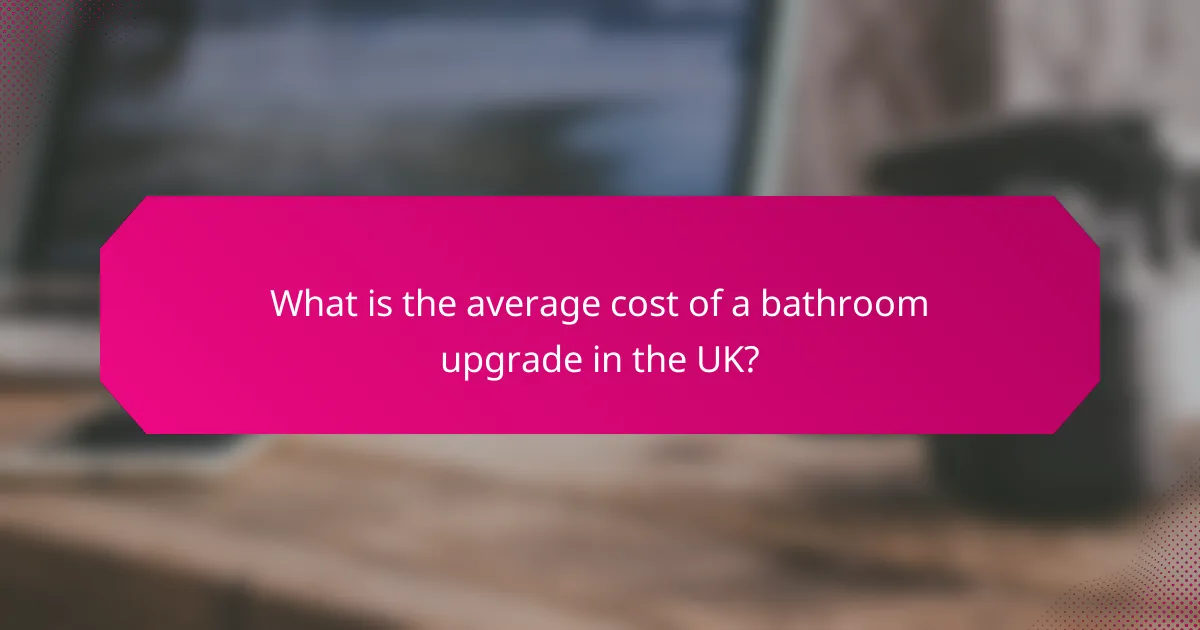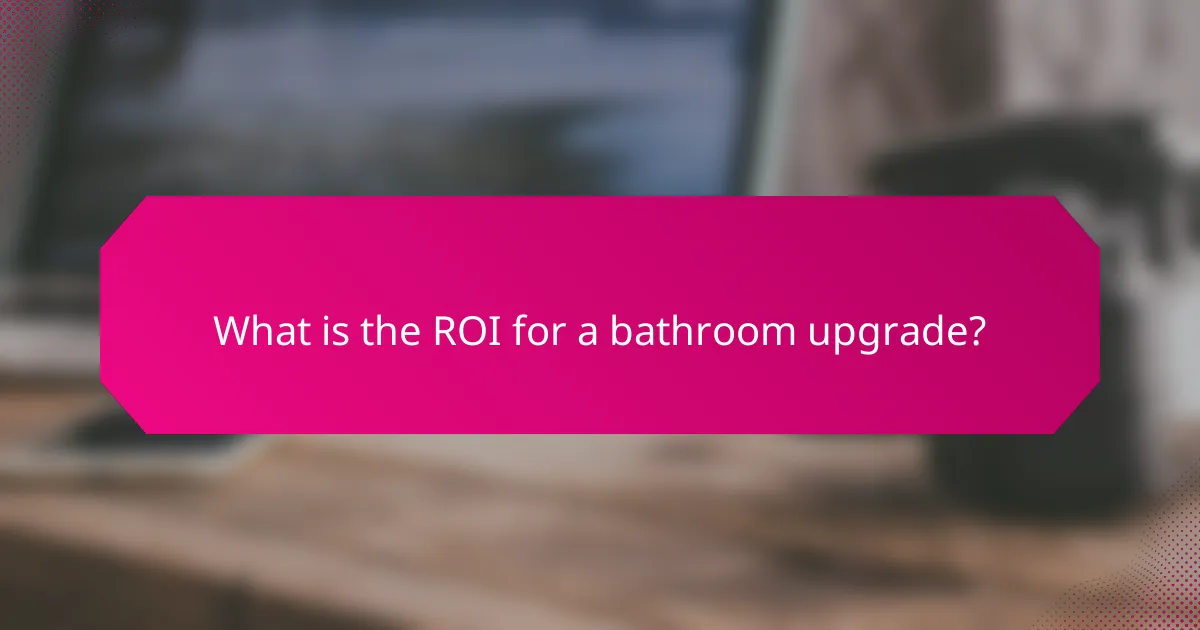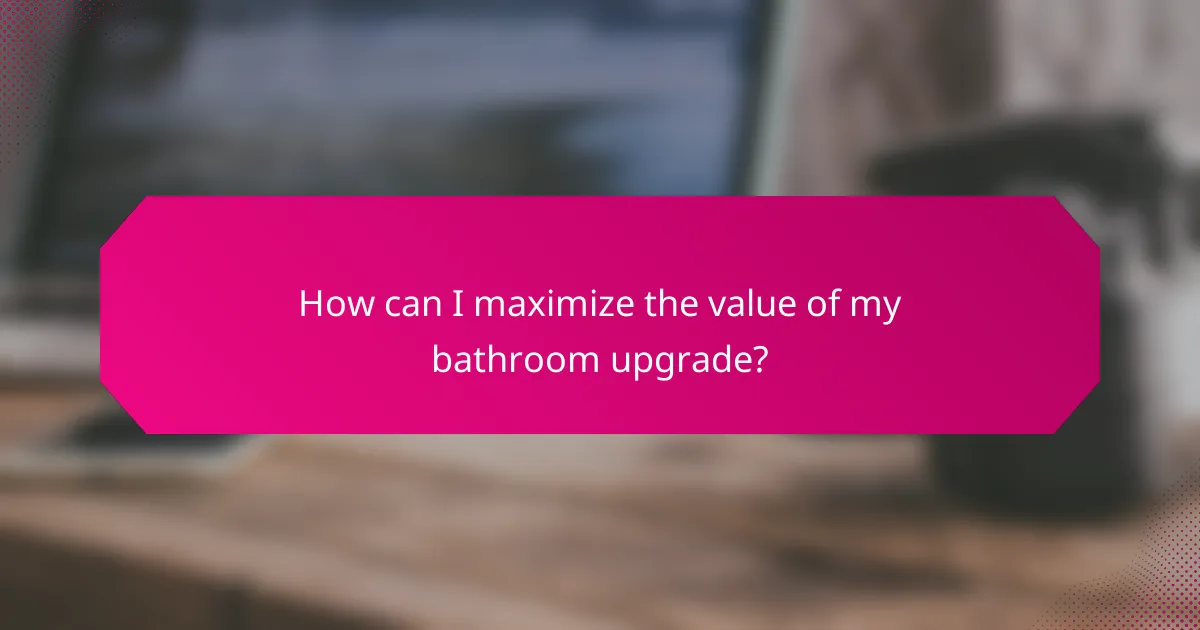Upgrading your bathroom can be a significant investment, with costs in the UK typically ranging from £5,000 to £15,000 based on renovation scope and material quality. Understanding the potential return on investment, which can vary from 60% to 100%, is crucial for homeowners looking to enhance their property’s value. Effective budgeting strategies involve prioritizing needs and wants while carefully assessing all associated costs to ensure a successful renovation.

What is the average cost of a bathroom upgrade in the UK?
The average cost of a bathroom upgrade in the UK typically ranges from £5,000 to £15,000, depending on the extent of the renovation and the quality of materials used. Factors such as labor, fixtures, and design choices significantly influence the overall expense.
Cost breakdown by project type
Bathroom upgrades can vary widely in cost based on the type of project. A simple refresh, including new paint and fixtures, may cost around £2,000 to £5,000. A full remodel, which involves structural changes and high-end finishes, can escalate to £10,000 or more.
Additional costs may arise from plumbing and electrical work, which are often necessary for more extensive renovations. Always budget for unexpected expenses, as older homes may have hidden issues that need addressing.
Average costs for fixtures and fittings
When budgeting for fixtures and fittings, consider that standard toilets can range from £100 to £300, while sinks and taps may cost between £50 and £500 each. Showers and bathtubs can vary significantly, with prices starting around £200 and going up to £1,500 or more for luxury options.
Investing in quality fixtures can enhance durability and aesthetics, but it’s essential to balance cost with functionality. Researching brands and comparing prices can help you find the best options within your budget.
Regional cost variations in the UK
Costs for bathroom upgrades can differ significantly across the UK. For instance, renovations in London may be 20-30% higher than in other regions due to higher labor costs and demand. In contrast, areas in the North may offer more competitive pricing.
It’s advisable to obtain multiple quotes from local contractors to ensure you get a fair price. Additionally, regional materials and labor availability can impact your overall budget, so consider these factors when planning your upgrade.

What is the ROI for a bathroom upgrade?
The return on investment (ROI) for a bathroom upgrade typically ranges from 60% to 100%, depending on various factors such as location, quality of materials, and market conditions. This means that homeowners can expect to recoup a significant portion of their renovation costs when selling their property or increasing its value.
Average ROI percentages in the UK
In the UK, the average ROI for a bathroom remodel is often cited between 60% and 70%. However, high-end renovations can yield returns closer to 80% or more, especially in sought-after areas. Homeowners should consider local market trends when estimating potential returns.
For example, a modest upgrade in a suburban area may return around 60%, while a luxury remodel in a city center could approach the higher end of the spectrum. It’s essential to align the upgrade with the expectations of potential buyers in the area.
Factors influencing ROI
Several factors influence the ROI of a bathroom upgrade, including the quality of materials used, the extent of the renovation, and the overall real estate market conditions. High-quality fixtures and finishes tend to attract buyers and can significantly enhance perceived value.
Additionally, the size and layout of the bathroom play a crucial role. Expanding a small bathroom or improving functionality can lead to higher returns. Homeowners should also consider the timing of their renovation; undertaking upgrades in a booming market can yield better returns than during a downturn.

How to budget for a bathroom upgrade?
To budget for a bathroom upgrade, homeowners should first determine their overall budget and prioritize their needs and wants. This involves assessing the costs of materials, labor, and any additional features while considering potential return on investment.
Budgeting strategies for homeowners
Start by setting a clear budget range for your bathroom upgrade. Typical costs can vary widely, often falling between a few thousand to over twenty thousand USD, depending on the extent of the renovation. Identify essential upgrades, such as plumbing or electrical work, and allocate funds accordingly.
Consider creating a detailed list of desired features, such as new fixtures, tiles, or cabinetry. Prioritize these items based on necessity and impact on the overall aesthetic. This approach helps in making informed decisions when unexpected expenses arise.
Common financing options
Homeowners have several financing options for funding a bathroom upgrade. Personal loans, home equity lines of credit (HELOC), and credit cards are popular choices, each with varying interest rates and repayment terms. For larger projects, a cash-out refinance may also be an option, allowing you to tap into your home’s equity.
Before choosing a financing method, evaluate your financial situation and compare potential costs. For instance, while credit cards may offer quick access to funds, they often come with higher interest rates. Conversely, a HELOC typically offers lower rates but requires equity in your home. Always read the fine print and consider consulting a financial advisor for tailored advice.

What are the key factors to consider before upgrading?
Before upgrading your bathroom, consider factors such as budget, design preferences, and the potential return on investment (ROI). Understanding these elements will help you make informed decisions and prioritize essential upgrades that enhance both functionality and aesthetics.
Essential features to prioritize
Focus on features that significantly improve usability and comfort. Common priorities include modern fixtures, efficient lighting, and adequate storage solutions. For instance, a double vanity can enhance convenience for families, while a walk-in shower may appeal to those seeking luxury.
Additionally, consider the plumbing and electrical systems. Upgrading outdated systems can prevent future issues and increase the overall value of your home. Investing in high-quality, water-efficient fixtures can also lead to long-term savings on utility bills.
Choosing materials and finishes
Selecting the right materials and finishes is crucial for both durability and style. Opt for moisture-resistant materials like ceramic tiles or vinyl flooring, which are practical for bathroom environments. Countertops made from quartz or granite can provide a balance of elegance and resilience.
When choosing finishes, consider the overall design theme of your home. Consistency in style can enhance visual appeal and create a cohesive look. Additionally, investing in quality finishes can reduce the need for future repairs, making it a wise long-term choice.

How can I maximize the value of my bathroom upgrade?
To maximize the value of your bathroom upgrade, focus on improvements that enhance functionality and aesthetics while appealing to potential buyers. Prioritize quality materials and popular design trends to ensure a strong return on investment.
Trends that increase home value
Current trends that can elevate your bathroom’s value include modern fixtures, open layouts, and spa-like features. Incorporating elements such as double vanities, walk-in showers, and high-quality tile can make a significant impact.
Consider using neutral color palettes and timeless designs to appeal to a broader audience. Features like heated floors or smart technology can also attract buyers looking for convenience and luxury.
Energy-efficient upgrades
Energy-efficient upgrades not only reduce utility costs but also attract environmentally conscious buyers. Installing low-flow toilets, energy-efficient lighting, and water-saving faucets can significantly enhance your bathroom’s appeal.
Additionally, consider adding insulation or energy-efficient windows to improve overall energy performance. These upgrades often qualify for local rebates or tax incentives, making them financially attractive options for homeowners.

What are the common pitfalls in bathroom renovations?
Bathroom renovations often face pitfalls that can derail budgets and timelines. Key challenges include overbudgeting due to unexpected costs and selecting an unsuitable contractor, both of which can lead to frustration and financial strain.
Overbudgeting and unexpected costs
Overbudgeting is a frequent issue in bathroom renovations, often stemming from unforeseen expenses. Homeowners should anticipate costs for materials, labor, and potential structural changes, which can add up quickly.
To mitigate this, create a detailed budget that includes a contingency fund of around 10-20% of the total project cost. This buffer can help cover unexpected expenses like plumbing issues or design changes that arise during the renovation process.
Choosing the wrong contractor
Selecting the wrong contractor can lead to poor workmanship and delays. It’s crucial to thoroughly vet potential contractors by checking references, reviewing past projects, and ensuring they are licensed and insured.
Consider obtaining multiple quotes to compare not just prices but also the scope of work included. A contractor with a solid reputation may charge more upfront but can save you money in the long run through quality work and adherence to timelines.

What are the latest trends in bathroom design?
The latest trends in bathroom design focus on creating functional yet aesthetically pleasing spaces that enhance relaxation and efficiency. Key elements include sustainable materials, smart technology integration, and personalized design choices that reflect individual styles.
Popular styles in 2023
In 2023, popular bathroom styles include modern minimalism, rustic charm, and spa-like retreats. Modern minimalism emphasizes clean lines and neutral colors, while rustic charm incorporates natural materials like wood and stone for a warm, inviting feel.
Spa-like retreats are gaining traction, featuring elements such as soaking tubs, rainfall showerheads, and ambient lighting to create a tranquil atmosphere. These designs often prioritize comfort and relaxation, making the bathroom a personal sanctuary.
Additionally, bold colors and patterns are making a comeback, with many homeowners opting for statement tiles or vibrant paint choices to add character. When choosing a style, consider how it complements the rest of your home and your personal preferences for functionality and aesthetics.
